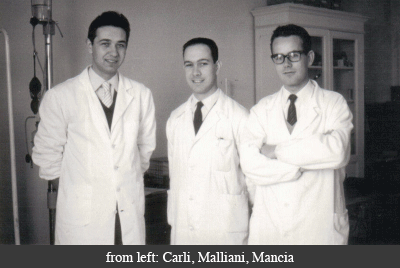
Biography
Giancarlo Carli education was greatly affected by several masters and mentors. In the high school, Carlo Ciampolini, professor of phylosophy and polititian, first strongly oriented his humanist believes. His scientific education began on November 1959 when, as a medical student at Siena University, applied for an internship at the Medical Pathology Institut. This changed his life style for ever. The head of the Institut, Cesare Bartorelli was a neurophysiologist that had moved to the clinic, but dedicated all his efforts in recruiting excellent investigators and in collecting Italian and foreign grants to develop competitive scientific projects. Indeed, Carli had the opportunity to meet young medical doctors such as Alberto Zanchetti, Alberto Malliani and Emilio Bizzi that greatly influenced his scientific education and his mentality. Zanchetti, indeed, had received a neurophysiologic training in Pisa where he had published a long series of original papers on the reticular formation of the brain stem and was motivated to pursue his work in this field.
After one year of intensive training, Carli started a new project with Zanchetti on REM sleep, a sleep phase that had been recently discovered. The project, in spite of strong initial difficulties, provided new findings and interpretations about the connections between brain stem and hippocampus that were published in Science. When Carli moved to Pisa to the Pompeiano lab, they discovered that presynaptic inhibition was responsible for the block of somatosensory transmission during REM sleep. Thanks to these results on REM sleep, in 2003 Giancarlo Carli received an Award as a pioner on sleep studies by the International Society for Study of Sleep.
After two additional years in Pisa, working under the supervision of Giuseppe Moruzzi on animal hypnosis/tonic immobility, Carli moved to Baltimore where he completed his basic training on somatosensory system. In particular, Vernon B. Montcastle taught him how to record cutaneous and deep hand receptors activity in monkeys and Robert LaMotte how to train monkeys to perform a psychophysical task.
After two years, Carli went back to Siena University where he started his academic carrier. At the same time, Carli developed his first program on pain and tonic immobility in Pisa with Louis Lefebvre, a PhD student from Universitè de Montreal. In the following years the work on pain was encouraged by Paolo Procacci, Professor of Internal Medicine at University of Firenze, John J. Bonica, Professor of Anesthesiology, University of Washington,Seattle, and by Manfred Zimmermann, Professor of Physiology ,University of Hidelberg. Carli and Zimmermann had an intense collaboration on many education activities including a class on pain to medical students at Siena.
The term “animal hypnosis” and the consideration that it did not define the same phenomenon in humans stimulated the interest of Carli to attend some Congresses on human hypnosis. Martin Orne, Professor at Pennsylvania University, and Ernest Hilgard, Professor at Standford University, convinced him to join the courageous army of reserchears engaged in human the field of hypnosis. Finally, on 1993, after a brief stage at Columbia University in the Crawford Clark psychophysics laboratory, Carli moved his interest to chronic pain in humans.

